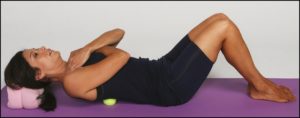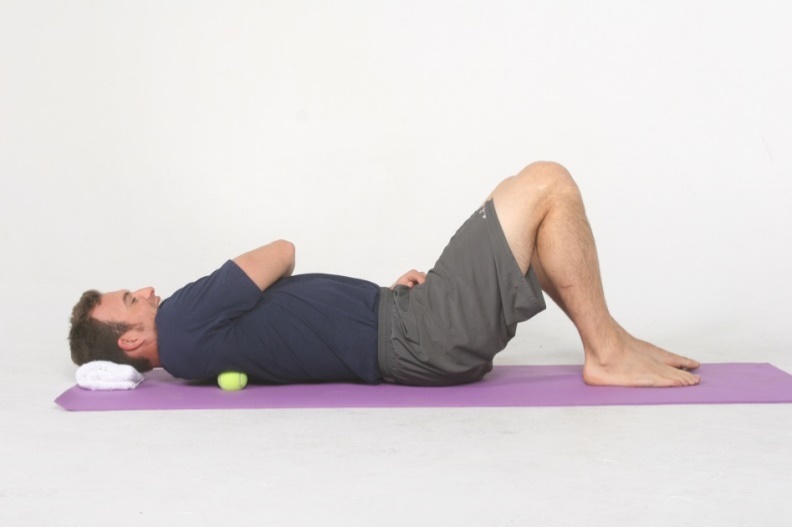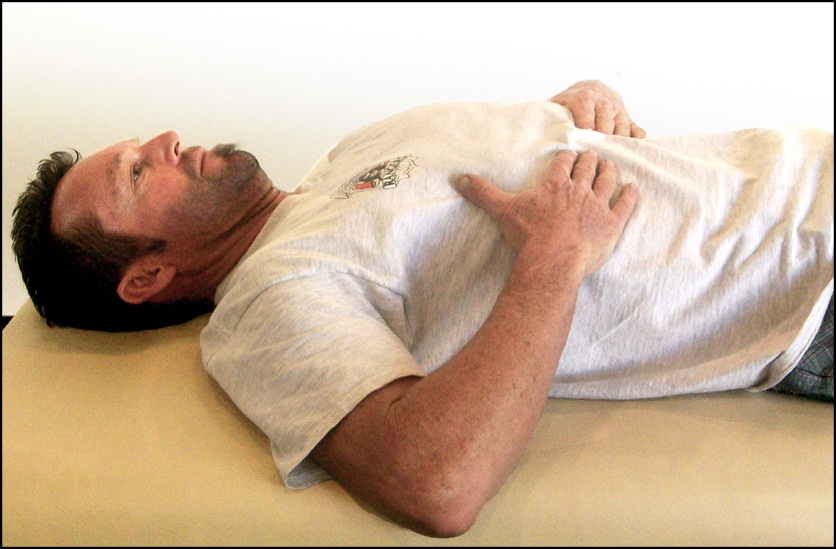
Want to improve your posture and learn how to fix rounded shoulders? Let’s begin by first taking a look at your posture.
Rounded shoulders is a disproportionate forward rounding or curvature of the middle and upper back.3 It is a common postural imbalance that can be caused by prolonged standing/sitting positions, exercise and/or activity choice, environmental factors, muscle dysfunction and psychological stress. Body responses to rounded shoulders include musculoskeletal aches and pains, breathing problems, limited function, impaired athletic performance and increased mental stress (according to The BioMechanics Method Corrective Exercise Specialist certification).1, 2,6,7,9
Causes of Rounded Shoulders
Musculoskeletal Compensations
Postural imbalances anywhere in the body can cause rounded shoulders. For example, when a person moves their head forward of its optimal position to focus their eyes on an object, like their phone, the upper back must round forward to help hold up the head.3 This is akin to having a large fish on the end of a flexible fishing rod. The rod will bend forward to accommodate the extra weight. Over time, this forward head position can lead to rounded shoulders.8
Muscle imbalances and restrictions can also lead to rounded shoulders. For example, when the arms are across and in front of the body for prolonged periods during activities like cooking, driving, and typing, the chest muscles become chronically shortened. Over time this causes the shoulder blades to move forward on the ribcage and the entire upper back and shoulder region to round forward.7
Environmental Factors
Respiratory conditions such as asthma, COPD, and allergies to air pollutants can affect the body’s breathing mechanisms and ability of the diaphragm to contract and relax correctly. Ribcage restrictions caused by chronic breathing problems can result in immobility of the thoracic spine and eventually excessive rounding of the shoulders.9
Exercise/Activity Choices
Exercise and activity choices can also contribute to rounded shoulders. Prolonged periods of spine flexion, such as is required for bike riding and/or spinning, martial arts, freestyle swimming, and hobbies like knitting and gardening, all can cause rounded shoulders.7
Psychological Stress
When the brain perceives a threat, whether real or imagined, the body physically prepares to take action against the threat (i.e., “flight or fight response”). Typical reactions include jaw tensing, tightening the abdominals, holding one’s breath, and rounding of the shoulders.2 Consequently, ongoing psychological stressors such as career dissatisfaction, relationship troubles, money problems, or family issues can bring about changes in the body that result in rounded shoulders.
Symptoms of Rounded Shoulders
Rounded shoulders can manifest as a variety of symptoms.
Pain
Rounded shoulders are usually accompanied by overarching of both the lower back and neck. These positions of the spine can lead to pain, disc generation, and nerve compression.5
Limited Function
The excessive flexion of the middle and upper back characteristic of rounded shoulders limits shoulder function, which can make activities like raising your arms to wash your hair, putting dishes in an overhead cupboard, or pulling on a sweatshirt difficult.
Poor Health and Disease
Rounded shoulders can affect respiration, which in turn, can restrict blood supply to internal organs. The downward movement of the diaphragm as it contracts helps massage the liver and bring blood supply to other vital organs. Hence, the disruptive nature of rounded shoulders on respiration can lead to any number of intestinal problems and/or disease.9
Increased Stress
When the body assumes a rounded shoulder posture, it is interpreted by the nervous system as stress. Over time this increased activity in the “stress areas” of the brain causes fatigue, resulting in the body (and brain) no longer being able to effectively cope.4
Corrective Exercises
Self-massage techniques are very effective technique for fixing a rounded shoulder posture.
Exercise #1: Two Tennis Balls on Upper Back

Lie on the floor on your back with your knees bent. Place a tennis ball on either side of your spine in line with the bottom of your shoulder blades. Use a large pillow to support your head so you don’t feel too much pressure from the tennis balls. Bring your arms across your chest and hug yourself. Find a sore spot and maintain pressure on it until it releases (10-15 seconds). Then move the balls to another sore spot by scooting your butt and body down so the balls roll up your spine. Bring the pillow with you each time you scoot. Spend about 2–3 minutes each day on the entire area.
Exercise #2: Tennis Ball Around Shoulders
This self-massage technique helps releases tension in the muscles/fascia that can become painful as a result of rounded shoulders.

Lie on the floor with your knees bent and head resting on a pillow. Reach one arm across your chest and place a tennis ball beside the shoulder blade of that arm between the shoulder blade and the spine. Find a sore spot and hold to release tension (10-15 seconds). Move the balls to another sore spot by scooting your body up or down. Do each side for about 2 to 3 minutes.
Breathing and Relaxation Techniques are also great for helping cure rounded shoulders. They help mobilize the ribcage, strengthen the diaphragm, supply blood to the organs, and promote relaxation and decreased stress.
Exercise #3: Lower Rib Expansion

Lie on your back with your knees bent (support your head with a small pillow, if necessary). Place your hands, palm down, around the bottom of your ribcage. Practice breathing in and out through your nose. As you breathe in, focus on the lower ribs expanding and pushing into the palms of your hands. Hold the breath (i.e., a diaphragmatic contraction) for a few seconds and then slowly breathe out. Do a total of 10 – 15 breaths every day.
Knowing Your Stress Triggers can also help. Mental stress can manifest as rounded shoulders, muscular pain, breathing problems, dizziness and headaches. Once you become aware of your stress triggers, concentrate on making choices that limit your exposure to these types of situations whenever possible to help fix rounded shoulders.
Keeping Rounded Shoulders at Bay
The key to the fix for rounded shoulders is paying attention to symptoms such as musculoskeletal pain, mental stress and decreased performance. Employ strategies, such as those outlined above, to help moderate the impact of your lifestyle and activities on your body and avoid the potentially harmful effects of this common postural problem.
To learn more about the causes and cures for both your own and your clients’ aches and pains, check out the fitness industry-s highest rated corrective exercise specialist certification program –The BioMechanics Method or click on the image below.
References
1Cook, Gray. 2010. Movement. Aptos, CA: On Target Publications.
2Hanna, Thomas. 1988. Somatics. Reawakening the Mind’s Control Of Movement, Flexibility and Health. Cambridge, MA: Da Capo Press.
3Kendall, F.P. et al. 2005. Muscles Testing and Function with Posture and Pain (5th ed.). Baltimore, MD: Lippincott Williams & Wilkins.
4Lawlis, Frank. 2008. The Stress Answer. London: Penguin Books.
5McGill, Stuart. 2002. Low Back Disorders: Evidence Based Prevention and Rehabilitation. Champaign, IL: Human Kinetics.
6Myers, T. 2001. Anatomy Trains. Myofascial Meridians for Manual and Movement Therapists. Edinburgh: Churchill Livingstone.
7Price, J., and M. Bratcher. 2018. The BioMechanics Method Corrective Exercise Specialist Certification Program. 2nd Ed. San Diego, CA: The BioMechanics Press.
8Price, J. 2018. The BioMechanics Method for Corrective Exercise. Champaign, IL: Human Kinetics.
9Rolf, I. P. 1989. Rolfing: Reestablishing the Natural Alignment and Structural Integration of the Human Body for Vitality and Well-Being (revised edition). Rochester, VT: Healing Arts Press
